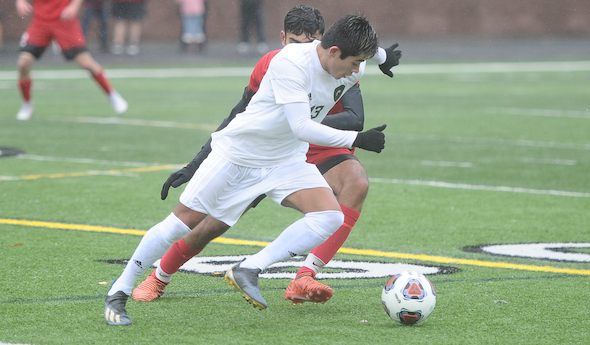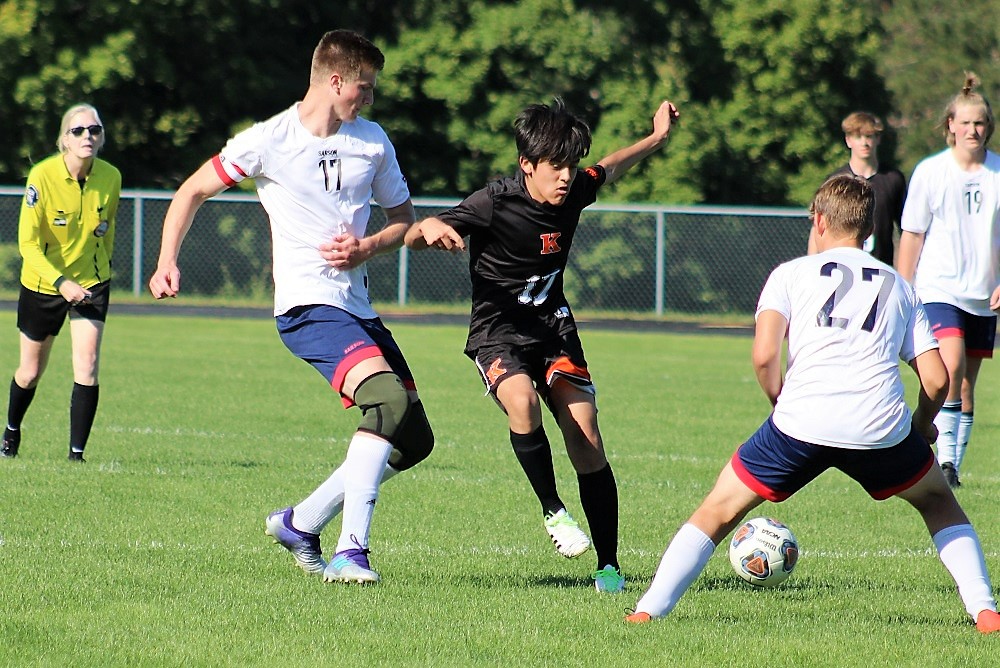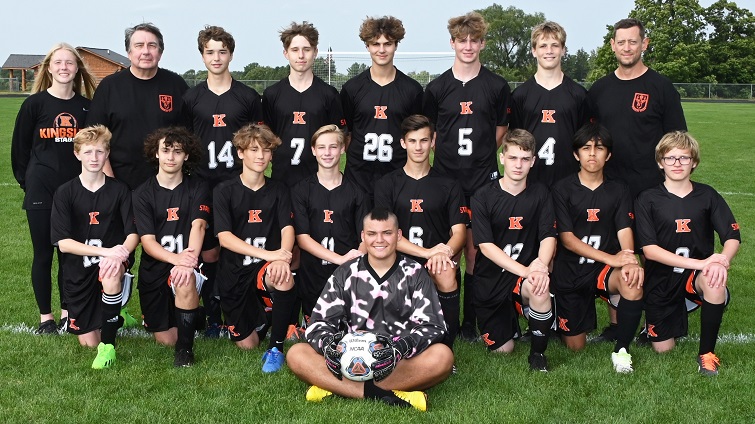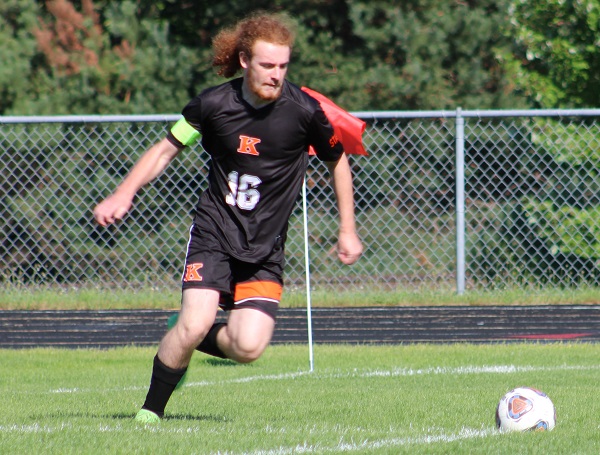
Preview: Finals Provide 1st & 2nd Chances
By
Geoff Kimmerly
MHSAA.com senior editor
November 6, 2020
This Michigan high school boys soccer season started with unpredictability because of COVID-19. It will end Saturday with opportunities – some enjoyed for the first time, others as second chances.
The Division 4 Final is guaranteed to produce a first-time champion, as Adrian Lenawee Christian and Grandville Calvin Christian are both first-time finalists. Division 2 is similar – DeWitt is seeking its first title, and Richland Gull Lake is seeking its first outright after earning a pair of shared championships more than two decades ago.
And then there are the second chances. In Division 3, Grosse Ile and Grand Rapids South Christian will meet on the season’s final day for the second-straight year; Grosse Ile claimed a 2-1 shootout win in 2019. In Division 1, Detroit Catholic Central and Traverse City West both are seeking the second championships in their programs’ histories – West after finishing second in Division 1 in 2019.
Here’s Saturday’s schedule:
NOVI
Division 3: Grosse Ile vs. Grand Rapids South Christian, noon
Division 4: Adrian Lenawee Christian vs. Grandville Calvin Christian, 3 p.m.
COMSTOCK PARK
Division 1: Traverse City West vs. Detroit Catholic Central, noon
Division 2: DeWitt vs. Richland Gull Lake, 3 p.m.
All of Saturday’s Finals will be broadcast live and viewable with subscription on MHSAA.tv, with audio available on MHSAANetwork.com. See below for glances at all eight finalists, and come back to Second Half later Saturday for coverage of all four championship games. (The Michigan Power Rating noted below is derived from a team's success and strength of schedule and was used to seed Districts at the start of the postseason. The MPRs listed were where teams ranked at the start of District play.)
Division 1
DETROIT CATHOLIC CENTRAL
Record: 12-0-3
Michigan Power Rating: No. 1
Coach: Gene Pulice, ninth season (121-27-23)
League finish: First in Detroit Catholic League Central
Championship history: Division 1 champion 2017.
Players to watch: Clay Moscovic, sr. F (7 goals, 2 assists); Jack Leuker, sr. M (5 goals, 6 assists); Ali Jaffer, soph. F (8 goals, 5 assists); John Browning, sr. GK (0.47 goals-against average, 6 shutouts).
Outlook: The Shamrocks are back at the Finals for the second time in four seasons to cap a run that’s included wins over No. 3 Mattawan and No. 6 Warren De La Salle Collegiate, one of three opponents that dealt them a draw during the regular season. (The others were No. 15 Fenton and No. 5 Troy Athens.) Moscovic made the all-state third team and junior midfielder Vincent Stockton (five goals, one assist this fall) earned an honorable mention in 2019.
TRAVERSE CITY WEST
Record: 22-1-2
Michigan Power Rating: No. 2
Coach: Matt Griesinger, sixth season (191-23-13)
League finish: First in Big North Conference
Championship history: Division 1 champion 2006, runner-up 2019.
Players to watch: Blade Kalbfleisch, sr. GK (1.08 goals-against average, 7 shutouts); Gavin Michael, sr. F (24 goals, 10 assists); Colin Blackport, jr. M (19 goals, 29 assists); Tony Gallegos, sr. F (18 goals, 9 assists).
Outlook: West is seeking to take the final step after falling to Troy Athens in last season’s Division 1 Final, and the Titans defeated Athens in Wednesday’s Semifinal to get that chance. West hasn’t lost since falling to De La Salle in its opener, and outscored its five postseason opponents by a combined 20-2. Gallegos made the all-state second team last season and Kalbfleisch earned an honorable mention. Senior Kaden Ales (8 goals/11 assists) and juniors John Hirschenberger (11/9) and Cooper Davis (8/7) fill out a high-scoring midfield.
Division 2
DEWITT
Record: 13-4-2
Michigan Power Rating: No. 6
Coach: Joe Ishraidi, sixth season (70-45-14)
League finish: Third in Capital Area Activities Conference Blue
Championship history: Has never played in an MHSAA Final.
Players to watch: Patrick Woodbury, sr. GK (1.18 goals-against average, 6 shutouts); Landon Hungerford, sr. M (24 goals, 9 assists); Zach Stephan, sr. F (9 goals, 15 assists); Victor Toune, sr. M (8 goals, 14 assists).
Outlook: Ishraidi, a former DeWitt standout during the first decade of the 2000s, has the annually-competitive Panthers heading into their first championship game. DeWitt dipped to 11-12-2 just two seasons ago but is 27-8-6 since, with wins this playoff run over No. 14 Dearborn Divine Child and No. 5 Riverview. Hungerford made the all-state first team, Toune the second and Woodbury earned honorable mention in 2019.
RICHLAND GULL LAKE
Record: 15-2-1
Michigan Power Rating: No. 3
Coach: Matt Streitel, fifth season (68-27-7)
League finish: Tied for first in Southwestern Michigan Athletic Conference
Championship history: Class B co-champion in 1993 and 1988, runner-up in 1983.
Players to watch: AJ Boucher, jr. M (3 goals, 19 assists); Eron Sylejmani, sr. M (21 goals, 15 assists); Tyler Corstange, jr. F (15 goals, 6 assists); Braden Minehart, fr. GK (0.22 goals-against average, 8 shutouts).
Outlook: Streitel has had the program building to this point, following up last season’s 17-1-1 finish with second-straight league and third-consecutive Regional championships – and a 2-0 win over DeWitt on Sept. 26. The Blue Devils defeated top-ranked Holland and avenged a loss to No. 12 St. Joseph during this playoff run. Sylejmani made the all-state second team last season, and Boucher made the third team.
Division 3
GRAND RAPIDS SOUTH CHRISTIAN
Record: 18-0-1
Michigan Power Rating: No. 4
Coach: Jason Boersma, 10th season (166-42-24)
League finish: First in O-K Gold
Championship history: Three MHSAA titles (most recent 2015), three runner-up finishes.
Players to watch: Jeff Herrema, sr. F (11 goals/14 assists); Nik Schepers, sr. GK (0.57 goals-against average); Thom DeVries, sr. M (12 goals/6 assists); Boston Knapp, sr. F (15 goals, 5 assists).
Outlook: The majority of last season’s top players are this season’s standouts again, with Herrema a returning all-state first teamer and Schepers having earned an honorable mention in 2019. Herrema isn’t expected to start; he reportedly suffered a shoulder injury two weeks ago. The Sailors haven’t lost again since falling in last year’s Final, with that lone draw this season with Division 1 Caledonia. South Christian downed No. 5 Wyoming Lee and No. 7 Hudsonville Unity Christian early this postseason and advanced to Saturday with a shootout win over No. 1 Elk Rapids. Junior Levi DeRuiter (3 goals/13 assists) is another cog helping to make the offense go.
GROSSE ILE
Record: 19-1-1
Michigan Power Rating: No. 2
Coach: Jon Evans, fifth season (114-6-9)
League finish: Second in Huron League
Championship history: Division 3 champion 2019 and 2002, runner-up 2018.
Players to watch: Clayton Lafayette, jr. M (4 goals, 16 assists); Bosh Tanyi, sr. M (45 goals, 8 assists); Drew Cardinal, soph. F (7 goals, 11 assists); Hayden Watson, soph. GK (0.30 goals-against average, 15 shutouts).
Outlook: Despite graduating eight players who earned all-state recognition last season, Grosse Ile is right back where it ended 2019. Tanyi is the offensive force after earning an all-state honorable mention in 2019, with four teammates putting up double-digit assists including as well freshman midfielder Ali Khaled (2 goals/14 assists) and junior midfielder Jon Duke (2/12). The Red Devils’ lone loss was to Division 2 No. 5 Riverview – the teams split this fall – and they tied Elk Rapids early. Grosse Ile has outscored its five playoff opponents by a combined 26-1.
Division 4
ADRIAN LENAWEE CHRISTIAN
Record: 15-2-1
Michigan Power Rating: No. 6
Coach: Nate Sharpe, fifth season (91-34-3)
League finish: First in Independent Soccer League
Championship history: Has never played in an MHSAA Final.
Players to watch: Francisco Cabrera, sr. M (9 goals, 9 assists); Gabe Henley, sr. F (14 goals, 8 assists); Evan Hendershot, sr. GK (0.88 goals-against average, 7 shutouts); Brennan Griffith, sr. M (24 goals, 14 assists).
Outlook: Lenawee Christian went over 20 wins for the second time in three seasons and has advanced to the Finals for the first time, with notable postseason wins over No. 12 Hillsdale Academy and top-ranked Plymouth Christian Academy. Sharpe does have experience at this level of the tournament; he led Hudsonville Freedom Baptist to the Division 4 title in 2009 and has more than 200 career coaching wins. Hendershot made the all-state second team last season, junior midfielder Jacob McKelvey (4 goals, 3 assists) made the third and Cabrera earned an honorable mention.
GRANDVILLE CALVIN CHRISTIAN
Record: 19-0-2
Michigan Power Rating: No. 9
Coach: Karel de Waal Malefyt, 11th season (146-60-24)
League finish: First in O-K Silver
Championship history: Has never played in an MHSAA Final.
Players to watch: Ethan DeJager, sr. GK (0.10 goals-against average, 18 shutouts); Lukas Lindhout, sr. F (20 goals, 11 assists); Jake DeYoung, sr. F (13 goals, 7 assists); Jack Hollebeek, jr. F (13 goals, 9 assists).
Outlook: Calvin Christian is in the midst of a two-year surge that has seen it go a combined 39-2-3 with a pair of league and District titles. The Squires defeated No. 10 Wyoming Potter’s House Christian and No. 14 Leland during this first-time Finals run, and downed its five playoff opponents by a combined 24-1. The regular-season draws came to Division 3 No. 5 Wyoming Lee and Division 1 Hudsonville. DeYoung earned an all-state honorable mention last season. Junior midfielder Nolan Karel (7 goals, 14 assists) and senior midfielder Luke Yonker (2 goals, 17 assists) have been leading distributors.
PHOTO: Traverse City West's Tony Gallegos (13) works to get past a Troy Athens defender during the 2019 Division 1 Final.

Records May Not Show It - Yet - But Kingsley Soccer Improving, Ready to Rise
By
Tom Spencer
Special for MHSAA.com
October 21, 2022
Kingsley did not go on unnoticed this fall in Northwest Conference soccer play.
 In fact, many took considerable notice of the Stags.
In fact, many took considerable notice of the Stags.
And, the coaches of the league’s top teams are looking for even bigger things ahead from Kingsley. Quite, frankly, they’re hoping it comes to fruition for their own teams’ sakes.
“It’s always beneficial to have a solid conference – as it helps teams prepare for playoffs,” said Rob Sirrine, coach of this year’s league title winner, Leland. “We expect them to improve in the next few years.
“Kingsley has had a rough go of it the last few years – not unlike other schools in our conference that also have football teams,” he continued. “I think they have some potential based on the coaches they have brought in and volunteers that are helping out the program.”
Second-year Kingsley head coach Tim VanWingerden welcomed Mike Alanson as a volunteer varsity assistant coach and two middle school coaches — Bert Baker and Lars Mitchell — this fall. Baker and Mitchell had kids on the Stags’ middle school squad this season.
League opponents, including the varsity coaches, noted big differences already.
Buckley coach John Vermilya, whose Bears finished second this year after winning the crown a year ago, echoed Sirrine.
“Kingsley has shown incredible resilience over the last three seasons,” Vermilya said. “This season they bounced back with an influx of young players, and you can see their growing tactical awareness along with technical ability.”
Youth soccer is growing in the Kingsley community as well, adding to the excitement. In fact, VanWindergen has two boys —Ted, 10, and Gunnar, 9, playing in the youth program. Tabatha VanWingerden, wife of the Stags’ head coach, is the coach of the U-12 team.
 Mitch Miggenburg, Kingsley’s athletic director, is pleased to see the growth in numbers as the Stags move through “a 3-5 year” plan to become more competitive in soccer and cross country. He’s hoping those sports can find success similar to that of the Stags’ football team.
Mitch Miggenburg, Kingsley’s athletic director, is pleased to see the growth in numbers as the Stags move through “a 3-5 year” plan to become more competitive in soccer and cross country. He’s hoping those sports can find success similar to that of the Stags’ football team.
Kingsley is 6-2 on the gridiron and looking ahead to the football playoffs again. The Stags are fielding a full squad of cross country runners this fall after some lean years.
With an enrollment of well under 500, Kingsley has been able to involve 62 boys in football, 10 in cross country and 17 in soccer. Miggenburg noted cuts had to be made to the school’s co-ed middle school team this fall.
“I think we’re headed in the right direction,” Miggenburg said. “If you look at our record, you might not see it.
“This is not something that is going to happen overnight,” he continued. “In order for us to develop the way we want to develop, we’ve got to put some time in outside the season. And we have some coaches willing to help and do that, and it will only benefit us in the future.”
The Stags have not won a game the last two seasons, but VanWingerden believes success, as defined by wins, is right around the corner. He knows his team has shown moments of brilliance in every contest before the goals mounted against the Stags.
VanWingerden and Kingsley have been praised for outstanding sportsmanship by referees, opposing players and coaches.
Other bright spots in 2022 included outstanding play by freshman goalie Nate Lamie and stellar defense by senior captain Zakkeus Bedford. The Stags will have to overcome the loss of Bedford, their only senior this year, who played with tremendous drive and was the leader on the field.
But, they should return rest of the squad hungry for wins. And, they’ll add some solid incoming freshman players.
 “I think next year is going to be a big turnaround,” VanWingerden predicted. “So the next two, three years, we’re going to start turning some heads.”
“I think next year is going to be a big turnaround,” VanWingerden predicted. “So the next two, three years, we’re going to start turning some heads.”
Despite not experiencing wins either of the last two seasons, the Stags have enjoyed playing soccer.
“There is a camaraderie there with these kids I just can’t quite put my finger on, but it’s part of what binds them better, facing that adversity on a regular basis and getting though it together as a team,” VanWingerden said. “They’ve come to practice the next day determined to work hard and try to improve little by little.
“The common goal to get better pulls them together and gives them a determination that is hard to find.”
Many conference games this year were played 9 vs. 9 or 10 vs. 10 per conference agreement. Benzie Central and Glen Lake played with fewer than 11 players in every contest this season. Benzie Central, Glen Lake, Kingsley and Suttons Bay all compete in cross country, football and soccer. Leland and Buckley do not field football squads.
The Comets won a District championship 1-0 on Thursday at Suttons Bay. The Bears are playing in a District Final on Saturday in Lakeview. Kingsley’s 0-19 season ended with a Division 3 District-opening loss to Boyne City last week.
The Stags have already begun working on next year. Offseason plans include drop-in soccer and participation in a newly-developed strength and conditioning program.
“The program is not going to move forward unless we put in a ton of work,” VanWingerden acknowledged. “We’ve had glimpses into what we could be if we did it on a regular basis.
“It is really encouraging.”
 Tom Spencer is a longtime MHSAA-registered basketball and soccer official, and former softball and baseball official, and he also has coached in the northern Lower Peninsula area. He previously has written for the Saginaw News, Bay County Sports Page and Midland Daily News. He can be reached at [email protected] with story ideas for Manistee, Wexford, Missaukee, Roscommon, Ogemaw, Iosco, Alcona, Oscoda, Crawford, Kalkaska, Grand Traverse, Benzie, Leelanau, Antrim, Otsego, Montmorency, Alpena, Presque Isle, Cheboygan, Charlevoix and Emmet counties.
Tom Spencer is a longtime MHSAA-registered basketball and soccer official, and former softball and baseball official, and he also has coached in the northern Lower Peninsula area. He previously has written for the Saginaw News, Bay County Sports Page and Midland Daily News. He can be reached at [email protected] with story ideas for Manistee, Wexford, Missaukee, Roscommon, Ogemaw, Iosco, Alcona, Oscoda, Crawford, Kalkaska, Grand Traverse, Benzie, Leelanau, Antrim, Otsego, Montmorency, Alpena, Presque Isle, Cheboygan, Charlevoix and Emmet counties.
PHOTOS (Top) Kingsley’s Rolando Torres works to gain possession against Traverse City Bulldogs’ Tyler Ritola (17), Jonathon Scott (27) and Syrus Ritola (19), as Josephine Arrowood officiates. (Middle) This fall’s Kingsley soccer team. (Below) Zakkeus Bedford lines up a kick this season. (Photos courtesy of the Kingsley athletic department.)

